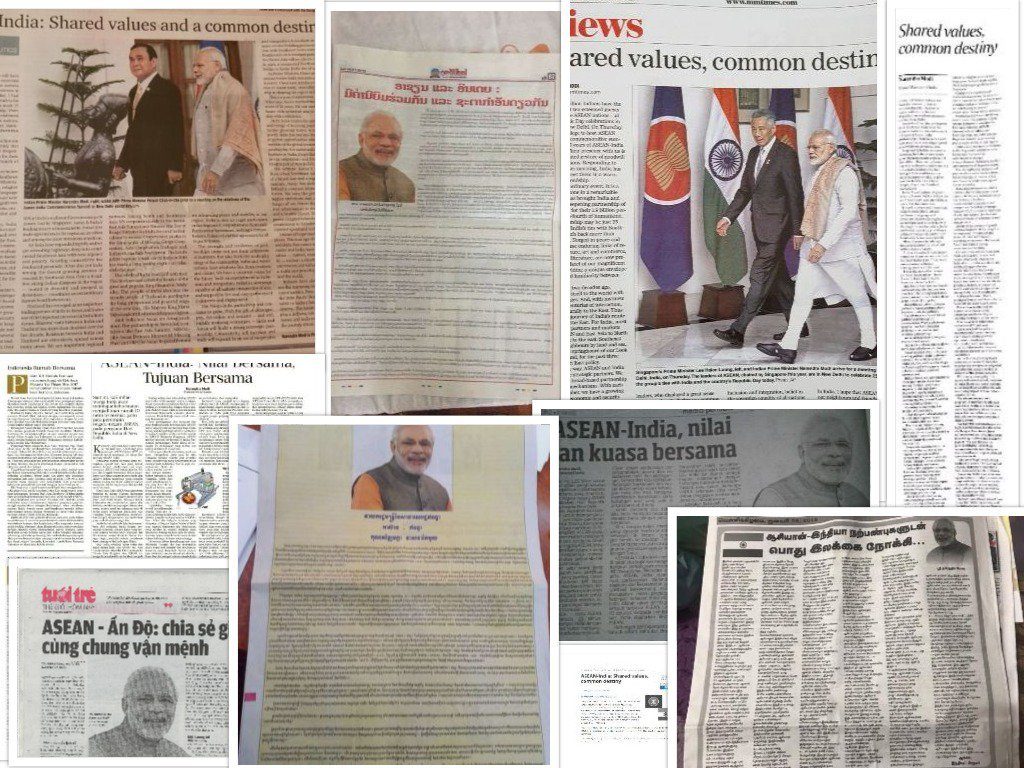

New Delhi: India rolled out a red carpet to welcome leaders from the Association of Southeast Asian Nations (ASEAN) to mark 25 years of New Delhi’s ties with the ASEAN bloc.
All 10 heads of states from ASEAN (comprising of Singapore, Cambodia, Vietnam, Indonesia, Malaysia, Thailand, Myanmar, Philippines, Laos and Brunei) were invited as chief guests at India’s 69th Republic Day celebrations.
PM Narendra Modi addressed the leaders of the ASEAN Summit after holding a series of bilateral talks.
“It is India’s privilege to host the ASEAN leaders. The leaders will be our honored guests at the Republic Day celebrations… Since 1992 our partnership has evolved, we have made success in implementing objective of ASEAN-India partisanship for peace, progress and shared prosperity through five year plan of action,” the PM said.
Speaking at the Plenary Session of the India-ASEAN Commemorative Summit the Prime Minister remarked, “This Summit is the grand finale of our joint year-long commemorative activities, organized in India and in ASEAN countries, which provides us a valuable opportunity to review our journey so far and chart our future path. This objective, in my view, is best served through free and friendly discussion among us.”
PM Modi has always stressed on establishing a personal rapport with world leaders and this was evident during the visit of ASEAN leaders in New Delhi.
All 10 heads of States from Thailand, Vietnam, Indonesia, Malaysia, the Philippines, Singapore, Myanmar, Cambodia, Laos and Brunei were treated to personalized hospitality. According to media reports there were customized upholstery for the leaders during their hotel stay and their room keys depicted respective flags.
From Look East to Act East
Even before formally taking charge of office, Prime Minister-elect Narendra Modi invited the heads of the governments of all South Asian states to attend his swearing-in. This gesture was without precedent because no world leader had been invited to attend what was traditionally considered a domestic event.
Leaders from Pakistan, Nepal, Bangladesh, Afghanistan, Bhutan, Sri Lanka, Mauritius and Maldives descended on New Delhi to attend the ceremony. This move was a big political statement from Modi that signified India’s arrival on the world stage.
In 1991, India adopted “Look East” policy to strengthen trade and strategic relations with Southeast Asian nations. However, the progress was slow.
After coming to power in 2014, Modi renamed the “Look East” policy to “Act East”, with commerce, connectivity and culture as the guiding themes to boost engagement with the region bloc.
Establishing better relations with its Southeast Asian neighbors has always been a top priority for the Prime Minister.
India’s trade with ASEAN has grown from $2.9bn in 1993 to $71bn last year, compared with China-ASEAN trade at $450bn. Beijing aims to take the trade to $1 trillion by 2020.
India shares ASEAN’s vision of peace and prosperity through a rules-based order for the oceans and seas. Respect for international law, notably UNCLOS is critical for this. ASEAN-India cooperation in maritime domain is one of the key focus areas for growth and development of the Indo-Pacific region.
Humanitarian and Disaster Relief efforts, Security cooperation, and Freedom of Navigation are going to be the key focus areas for India-ASEAN Maritime cooperation. The Connectivity Summit was also an affirmation of the linkages that India shares with ASEAN through land, air, maritime, cultural, civilizational and people-to-people relations that date back centuries.
Surfing the Information Superhighway
Information and Communications Technology have the potential to forge new bonds of digital connectivity between India and ASEAN countries. These could include new areas of cooperation in a regional high-capacity fiber optic network, and a national rural broadband networks to digitally connect remote areas.
India offers to undertake a pilot project on rural connectivity, which would create digital villages in Cambodia, Lao PDR, Myanmar and Viet Nam. Success of this project could be replicated in other ASEAN countries.
India is also offering a training programme on Telecom and Networking Technologies, to share best practices in Policy, Regulation and Technological Development for Information and Communication Technology professionals from ASEAN countries.
Cultural Connectivity
People to people connectivity have been the foundation of close ties between India and ASEAN nations for hundreds of years. The Indian Diaspora has settled far and wide in Southeast Asia.
Speaking at the opening ceremony of the summit PM Modi proposed that the year 2019 should be declared as the ASEAN-India Year of Tourism to set up tangible and intangible cultural heritage circuits to further promote tourism. The Buddhist Tourism circuit could be an important part of this to attract tourists and pilgrims from different regions.
The PM also highlighted the role played by India in restoration works of historical structures in ASEAN countries. “It was a privilege for India to play a role in conservation works of temples in Cambodia, Myanmar, Lao PDR and Vietnam. A virtual knowledge portal of ASEAN India network of Museums could curate this shared heritage,” he said.
The PM also announced 1000 Fellowships to students and researchers from ASEAN countries for studying integrated PhD programmes in Indian Institutes of Technology.
To commemorate this historic event Prime Minister Modi wrote an op-ed on India-ASEAN relationship which was published in twenty-seven newspapers in 10 languages in 10 ASEAN countries.
“India and ASEAN have relations free from contests and claims and believe in sovereign equality of all nations irrespective of size, and support for free and open pathways of commerce and engagement,” Prime Minister Narendra Modi wrote.
In the past four years, PM Modi has toured extensively all over the world, including visits to all 10 ASEAN nations, as his government looks to boost trade ties with the biggest bloc in Southeast Asia.









